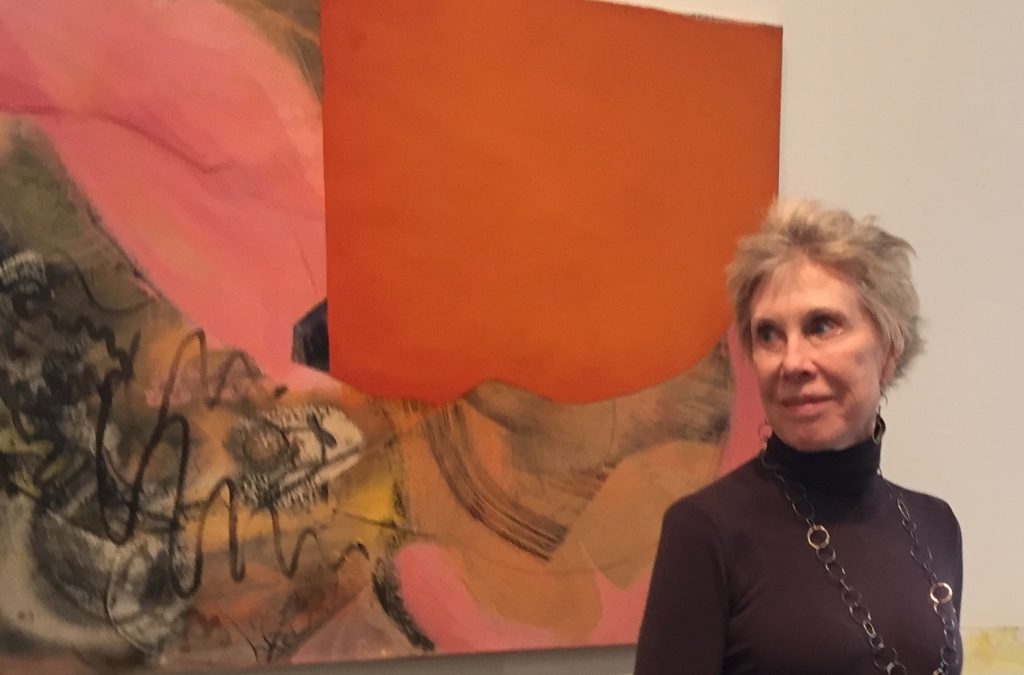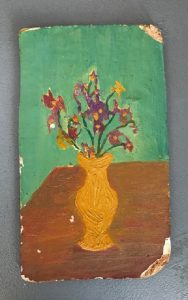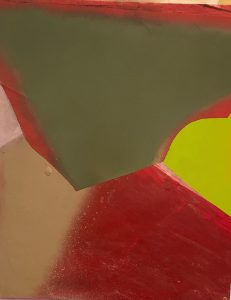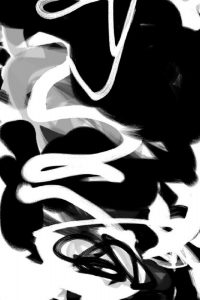By Phillis Ideal
I still see Big Mama leaning over her garden to pick a zinnia to put in her still life. Her old pink slip hung diagonally, a foot below her hiked-up stained dress, half-covered by her paint smock, which matched her white faux-fur bedroom slippers, both splotched with oil paint. Her long, faded, silky hair, which she wore swept up and bunched in a topknot, gave way and cascaded down her back.
Little Mama scoffed at her mother’s painting outfit. “I hope no one associates you with our clothing store.”
Big Mama let out her good-natured laugh. “Customers will be standing in line to buy this outfit. I am a trend setter.”
I loved my grandmother, so different from my brittle mother, who had handed me over to Big Mama when I was five weeks old at the time that my father died of a heart attack. After his death, Little Mama dove back into her previous single life of buying trips for the family clothing store or joining her friends most evenings when she was in town. I was too young to understand the effects of grief and the shock of the sudden loss of a spouse. All I knew was that she wasn’t attached to me like most mothers to their children, and I worried that I was unlovable.
But I felt good with Big Mama. Every morning we gardened: Big Mama thinned irises, pruned roses, planted new bulbs, and showed me how to dig shallow trenches around the garden’s edge and fix pansies in the moist ground. Big Mama cut the larger flowers—cannas and zinnia—and arranged them in a vase from the flea market, and then helped me position pansies, with their funny faces, in a tiny yellow glass vase.
I ran ahead of Big Mama to the studio, a ramshackle outbuilding behind the main house, where we would paint our flower still lifes. She trudged behind me and called out between labored breaths, “Put the purple velvet cloth on my table and put the green one on your table. Make sure you put some folds in my cloth, so there are some shadows. I will bring the flowers and you put oil paint on your palette. Don’t use too much and leave room for mixing. Remember to set it up properly like I told you. Keeping it the same way every time will get you off to a good start.”
I was beside myself that Big Mama would trust me to set up all by myself. I carefully put the oil colors on one side of the palette, laying out the colors from dark to light: brown, blue, green, red-purple, red, orange, yellow and white. It was not long before I called the colors by their names: Burnt Umber, Ultramarine Blue, Pthalo Green, Alizarin Crimson, Cadmium Red, Cadmium Yellow and Titanium White. When she caught up to me in the studio, she poured a small amount of varnish, not too much, with turpentine in the small tin cup and more turpentine in the large tin can for cleaning my brushes.
Sometimes she would pull out a big art book and point to a painting. “Try to make this green and see how wonderful it looks next to this red. They are called complementary colors and the artist’s name is Van Gogh”. I had barely started school and had no idea what she was talking about, but gradually I remembered artists’ names and could identify their work as I turned the pages of the big art book.
Whenever I would watch her paint and try to copy her, she would say, “Don’t copy me. You paint what you see and make something new. Use your own voice. You have something to say.”
Big Mama was my center, even though I pulled away from her when I started junior high. During this time of change, she sensed the low thrum of worry that ran through me like a constant current. She noticed my preoccupation with looking in the mirror, from head to toe and from all angles, checking out my unchanging tomboyish body, and looking at a face gone blank and wholly empty of myself. She listened to my worries about never feeling noticed or saying anything that hit the mark with the popular kids in school.. Big Mama always liked me exactly the way I was, and was puzzled that I didn’t agree with her.
I began to think Little Mama had answers. After all, she often said, “When I was young, I was the belle of the ball.” I began to listen to her criticisms of my hair, posture, and shyness, and to heed her suggestions of how to become popular. My concern as to how I would fit into this new world replaced painting with Big Mama.
Big Mama padded in and out of the house, moving through her routines, reaching out to give me a passing hug as long as I would let her. She spent more and more time in her bedroom. Close to my fifteenth birthday, I came home from school and found her standing in a puddle of water, staring out the kitchen window with the sink overflowing. She tried to speak, but couldn’t, or move her arm to turn off the water. I held her as tears poured down our cheeks. I rode with her in the ambulance that took her to Saint Mary’s Hospital, where she soon passed away.
I am easily the age of the grandmother who taught me to become a painter. My abstract paintings contain only distant echoes of those early flower paintings, but the passion and discipline she showed me from an early age remain. When I lose my way and the works turn to mud, I start over and hear her voice, “Remember to set it up properly the way I told you. Keeping it the same way every time will get you off to a good start. Use your own voice. You have something to say.”
Phillis Ideal, an artist who divides her time between Santa Fe and New York, shows regularly at David Richard. She was profiled for “Under the Radar” in 2016.
Top: The author and a recent painting




““Don’t copy me. You paint what you see and make something new. Use your own voice. You have something to say.” What a beautiful gift. Thank you for sharing this.
Loved this – very palpable and so visual !
A beautiful essay, Phylis Ideal. You are so fortunate to have a Big Mama!